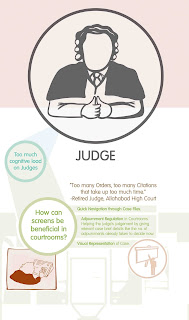(click on link to see the map in detail)
With some help in the illustrations in there from more capable persons, we have tried to include some of the ideas into our system model. The model itself uses the metaphor of a manufacturing process and how to fix the flaws at each of the error points.
PROPOSITION ONE.
Inspired by the complete traceability of the Passport making process and the existing system of the Legal Services Authority of the State, Gujarat, which collaborates with Legal Aid and Mediation Centres to aid the litigant.
A pamphlet as a guideline for the Key Stakeholder: The Litigant.
PROPOSITION TWO.
This proposition caters to the anxiety of the litigant at the points of wait inside and outside the courtroom. Once one subscribes to this service, at any point, one knows one will be informed about any updates regarding one's case.
Inspired by the access to information given by Mc. Donald's to its customers so they can make an informed decision.
A pamphlet as a guideline for the Key Stakeholder: The Litigant.
PROPOSITION THREE.
Management of adjournments, if and when possible, outside the courtroom will save precious court time. This, in the longer run, will add to quicker delivery of justice.
Inspired by the online appointment management system at VFS.
A pamphlet as a guideline for the Key Stakeholder: The Lawyer.
PROPOSITION FOUR.
A pamphlet on how the System will work; in what ways a screen can be beneficial to the courtroom.
Wireframes for the interface of such a System:





















